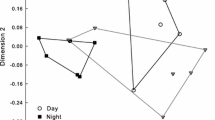Summary
The orchid Calypso bulbosa var. americana has deceptive flowers that provide no rewards for visitors. Near Banff, Alberta, the flowering period of this species is synchronized with the emergence of its pollinators, large bumblebee queens, in late spring. Calypso flowers appear to rely on the initial attraction and deception of newly-emerged naive bumblebees for pollination. Indirect evidence suggests that individual bees subsequently learn to avoid these flowers and that avoidance is learned quite rapidly. Avoidance behavior by pollinators is obviously detrimental to sexual reproduction in Calypso. This negative effect appears to be offset by the large number of seeds produced in plants which are effectively pollinated. A test of the hypothesis that Calypso flowers mimic flowers of the shooting star, Dodecatheon radicatum (Primulaceae) failed to provide evidence for mimicry.
Similar content being viewed by others
References
Ackerman JD (1975) Reproductive biology of Goodyera oblongifolia (Orchidaceae). Madroño 23:191–198
Ackerman JD (1981) Pollination biology of Calypso bulbosa var. occidentalis (Orchidaceae): A food-deception system. Madroño 28:101–110
Baker H (1975) Sugar concentrations in nectars from hummingbird flowers. Biotropica 7:37–41
Boyden TC (1976) Butterfly palatability and mimicry: Experiments with Ameiva lizards. Evolution 30:73–81
Dafni A, Ivri Y (1979) Pollination ecology, of, and hybridization between Orchis coriophora L. and O. collina Sol ex Russ (Orchidaceae) in Israel. New Phytol 83:181–187
von Frisch K (1971) Bees, their vision, chemical senses and language, 2nd edn. Cornell Univ Press, Ithaca, New York
Gumprecht R (1977) Seltsame Bestäubungsvorgänge bei Orchideen. Die Orchidee, Beilage zu Heft 28:5–23
Heinrich B (1979) Bumblebee economics. Harvard Univ Press, Cambridge MA
Kullenberg B, Bergstrom G (1976) The pollination of Ophrys orchids. Bot Not 129:11–20
Menzel R, Erber J (1978) Learning and memory in bees. Sci Am 239:102–110
Meeuse BJD (1961) The story of pollination. Ronald Press, New York
Mosquin T (1970) The reproductive biology of Calypso bulbosa (Orchidaceae). Can Field Nat 84:291–296
Mosquin T (1971) Competition for pollinators as a stimulus for the evolution of flowering time. Oikos 22:398–402
Stoutamire WP (1971) Pollination in temperate American orchids. In: Corrigan MJ (ed) Proc Sixth World Orchid Conf. Sydney, Australia, pp 233–243
Thien L, Marcks B (1972) The floral biology of Arethusa bulbosa, Calopogon tuberosus, and Pogonia ophioglossoides (Orchidaceae). Can J Bot 50:2319–2325
Vogel S (1978) Evolutionary shifts from reward to deception in pollen flowers. In Richards AJ (ed) The pollination of flowers by insects. Academic Press, New York, pp 89–96
Wollin H (1975) Kring nornans biologi. Fauna och Flora 70:89–98
Author information
Authors and Affiliations
Rights and permissions
About this article
Cite this article
Boyden, T.C. The pollination biology of Calypso bulbosa var. Americana (Orchidaceae): Initial deception of bumblebee visitors. Oecologia 55, 178–184 (1982). https://doi.org/10.1007/BF00384485
Received:
Issue Date:
DOI: https://doi.org/10.1007/BF00384485




